If you are a software tester, you already know the importance of testing techniques in software testing. However, do you know what the advantages and disadvantages of Software Testing are? They help to check whether we get the expected outcomes from a software system. Understanding the benefits and drawbacks of software testing and these techniques will assist you in boosting the software quality of your application quickly.
So are you curious about discovering the benefits and drawbacks of software testing?
Common Advantages and Disadvantages of Testing Techniques
Software testing is a process that helps to identify errors, bugs, or defects in a software program. It also verifies whether the software meets the requirements specified by the customer or client. Testing techniques vary depending on the level of testing being performed. There are various advantages and disadvantages of software testing that should be considered before starting the process at each level.
Let’s have a look at some of the most common ones for testing and enlist the drawbacks of software testing:
Advantages
- Eliminates software bugs, defects, and failures.
- Increases the efficiency of the software.
- Reduces the number of times the software needs to be repaired.
- Improves the quality of the software.
- The testing team can assists the software development team by detecting the mistakes made by them.
- Helps to optimize the code and get rid of unwanted lines of code.
- Prevents future problems, crashes, and complaints from the end users.
- Increases customer satisfaction and user experience.
- Saves time for test execution when automation testing is used.
- Manual testing doesn’t require knowledge of a programming language.
- Test cases and test scenarios that are written for an application may be reusable for other systems.
Disadvantages and Drawbacks
- Most testing types are time-consuming due to executing tests continuously. Thus, the failing tests should repeatedly run until fixing all the issues.
- Lack of experienced software and QA testers who are aware of testing techniques.
- The software testing team requires many members.
- Increases the cost of the software and the budget.
- Enhances the scope and increases the duration of the software development life cycle (SDLC).
- Identifying the exact testing techniques and types (eg: manual or automation testing, black box testing or white box testing, etc.) is required depending on the actual requirements.
- Many test management systems are expensive or clunky.
Types of Software Testing Techniques
As mentioned earlier, we need to use the most appropriate types of testing techniques depending on the requirements of the software application. Even though we use software techniques to detect bugs and defects, each testing technique has its distinct characteristics.
We can classify types of testing techniques into three main categories. They are:
- Functional Testing
- Non Functional Testing
- Maintenance Testing
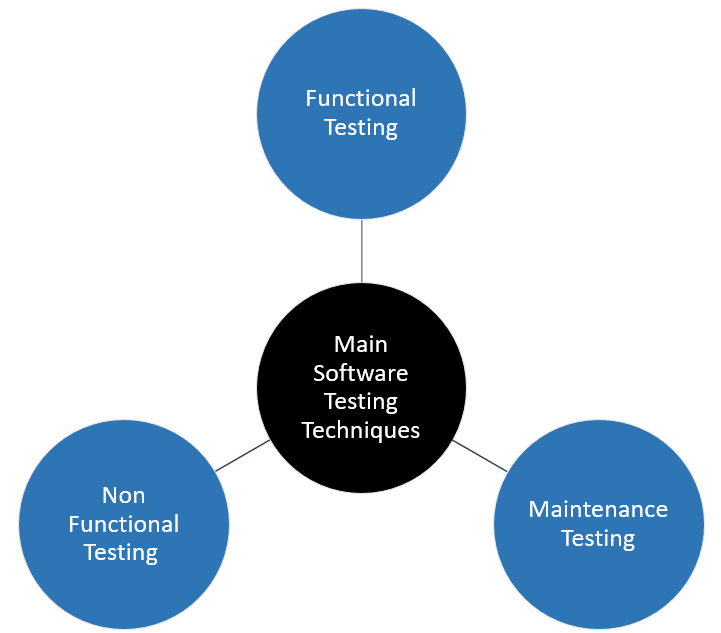

What are the Functional Testing advantages and disadvantages?
We use functional testing to ensure each application’s functionality is operating as expected and fulfilling the requirements. There are several functional testing types, as shown below. Four of them are known as the four levels of testing.
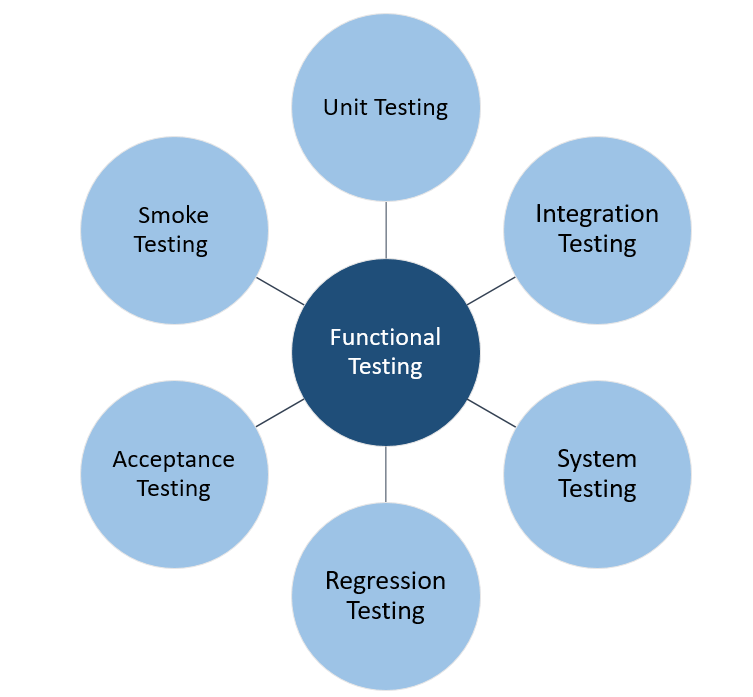

Unit testing
We use unit tests to test each module or unit in the software application. With this automated testing technique, we can verify the internal data structures, logic, and boundary conditions for a set of input and output data.
Advantages of Unit testing
- With unit testing, we can easily debug the code. Therefore, we can detect the bugs at the early stages of the software development life cycle (SDLC).
- It also allows us to reuse code lines repeatedly. Hence, the code can be improved and maintained easily.
- Overall reduction in testing cost and bug fixes due to uncovering bugs earlier in the process.
- Unit testing a quickly completed due to being automated.
Disadvantages of Unit testing
- Writing a good unit test script is a challenging task and time-consuming.
- You cannot guarantee the tested modules will work fine once they are integrated.
What are the advantages and disadvantages of Integration testing?
Learn the 5 amazing advantages of integration testing, and the 2 disadvantages of integration testing that will boost your application’s quality. Integration testing verifies whether an integrated set of individual units or modules are working as expected. In other words, we can link two or more distinct modules together and see whether they are working fine with integration testing. Let’s see the advantages and disadvantages of integration testing.
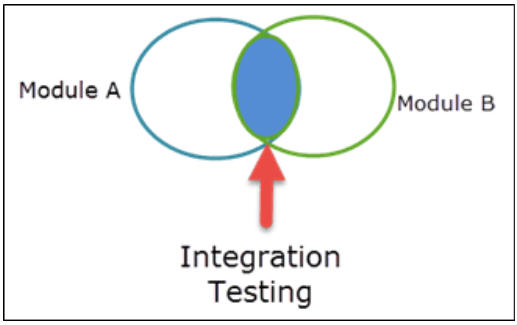
Advantages of Integration testing
- Integration testing assists us in recognizing the bugs when individual units are combined.
- Furthermore, integration testing guarantees the functionality of the integrated units is working as expected before carrying out system testing.
- Issued identifies during integration testing are easy to solve compared to the issues recognized at levels such as system and acceptance testing.
- Integration testing can uncover ad-hoc tests that we hadn’t thought of earlier.
- More importantly, integration testing increases test coverage.
Disadvantages of Integration testing
- Carrying out integration testing is challenging and consumes more time. This is because testing must occur between all the interfaces in the application. Hence it is also resource-intensive.
- In addition, failing to create stubs and drivers required for integration testing will result in poor testing.
What are the advantages and disadvantages of System Testing?
Learn the 5 amazing advantages of system testing, and the 2 disadvantages of system testing that will boost your application’s quality. In general, system testing determines whether the system elements are operating and functioning according to the given software requirements. In this software testing, the hardware and software components are combined and tested together. Let’s see the advantages and disadvantages of system testing.
Advantages of System Testing
- System testing covers the entire software through end-to-end software testing. As a result, we can verify whether the unification of the business requirements and software architecture performs well.
- Discovers bugs that will arise when releasing the application to customers.
- Boosts the team’s confidence of the product before undergoing acceptance testing.
- System Testing uses an environment similar to the production environment. Hence, the user’s confidence in the product is improved.
- Being a form of black box testing, testers do not need to understanding programming to complete this testing.
Disadvantages of System Testing
- Testing the entire system requires more time than other software testing types since the tests cover the whole software framework.
- The cost required for this testing process is also high as both the business requirements and the software architecture should be considered while carrying out the tests.
What are the regression testing advantages and disadvantages?
Learn the 5 amazing advantages of regression testing, and the 2 disadvantages of regression testing that will boost your application’s quality. We use regression testing to test the functionality of a software application when adding or modifying functionality. Hence, regression tests are the ideal testing technique to test software reliability after adding a new feature. One of the keys to successful regression testing is properly prioritizing regression test cases based on their business impact.

Advantages of Regression testing
- With regression testing, we can optimize the performance and the quality of the application. Regression testing also guarantees the same bugs will not appear again.
- Regression testing is ideal for implementing continuous integration as a build is triggered automatically when the developer pushes the code.
- Typically, automation tools carry out the vast majority of regression testing.
- Corrective regression testing helps to reduce retesting time when there are no changes in the specifications.
- Progressive regression testing ensures that an updated version of your software does not harm existing features.
Disadvantages of Regression Testing
- Executing manual regression tests becomes tedious and consumes more time due to running the same test cases.
- A minor modification added to the code will necessitate regression testing as the modification might affect the existing functionality.
What are the advantages and disadvantages of Acceptance Testing?
Learn the 3 amazing advantages of acceptance testing, and the 2 disadvantages of acceptance testing that will boost your application’s quality. Acceptance testing is the last type of functional testing. With acceptance tests, we can verify whether a fully developed application is ready or not for delivery. This testing technique ensures the implementation of business requirements. The two types of acceptance testing are Alpha testing and Beta testing. Let’s see the advantages and disadvantages of acceptance testing.
Advantages of Acceptance Testing
- It enhances the requirement definition and satisfaction of the system users as the users carry out this testing.
- Outlining the quality criteria of the software at the beginning of the software development life cycle (SDLC) makes carrying out acceptance tests much more straightforward.
- Executing acceptance tests gives some experience and knowledge about the application to the user.
Disadvantages of Acceptance Testing
- Sometimes the users do not want to participate in acceptance test processes.
- The users cannot comprehend the test cases defined by a software tester. Hence a software tester must assist the users by translating them to carry out the testing.
Smoke Testing
This testing technique tests the significant functionalities of an application continuously to verify the endurance and strength of the system.
Advantages of smoke testing
- It assists us by discovering the bugs occurring due to the integration of software modules. These bugs are detected during the early stage of the testing process.
- Only a finite number of test cases are needed to carry out this testing method.
Disadvantages of smoke testing
- Since this testing method does not perform in-depth testing, we cannot identify hidden critical issues.
Non-Functional Testing
Non-functional testing is equally important as functional testing. It assists us in verifying the non-functional aspects such as performance, usability, reliability, etc., of a software application. In other words, it tests the preparedness of an application according to non-functional parameters not approached by functional testing.
The following types of testing belong to non-functional testing.
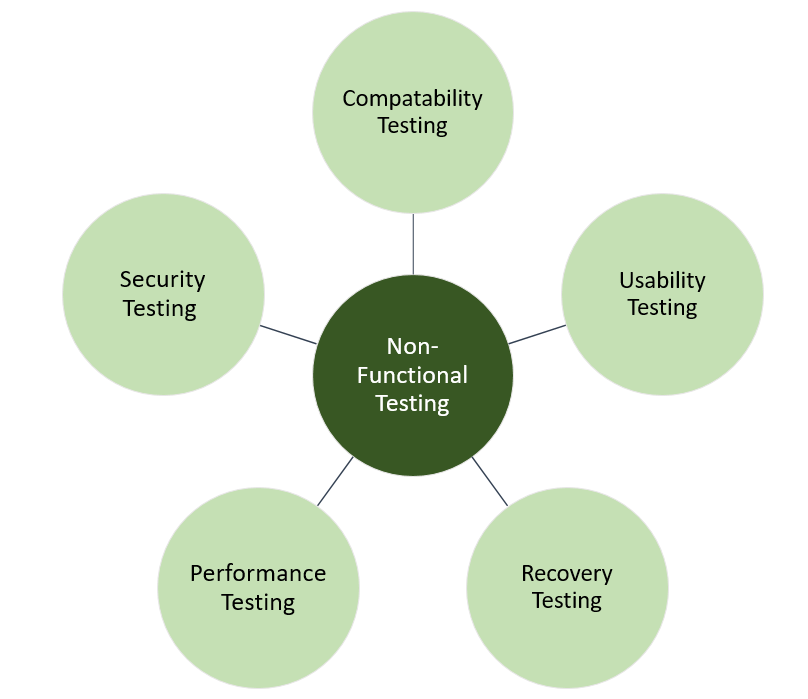

Security Testing
We use security tests to guarantee that the entire system is protected against security vulnerabilities.
Advantages of Security testing
- All companies follow a security policy, and with this testing, we can easily follow the guidelines in the policy.
- You can avoid threats from viruses and hackers with this testing method. Therefore, after completing this testing, the application can open up to the internet fearlessly.
Disadvantages of Security testing
- Any mistakes made while executing tests can be costly.
- Outlining test cases for security tests is not easy.
- Some forms of security testing can be unethical, illegal, or break terms and conditions.
What are the advantages and disadvantages of Performance Testing?
With performance testing, we can guarantee the software applications can handle and manage the workload efficiently. We can also measure the system’s performance metrics such as speed, stability, and response rate through performance testing.
Advantages of Performance Testing
- Performance testing verifies the speed, accuracy, and stability of the software match expectation.
- Performance testing assists the system by authenticating the responsiveness and managing the scalability and reliability of software features.
Disadvantages of Performance Testing
- Performance testing can be a costly mistake if done haphazardly, leading to inaccurate results and conclusions.
- Performance testing should be carried out on multiple devices in different locations to check whether a user faces difficulties. Hence this testing can be costly.
The following table exhibits three popular types of testing used for performance testing and their advantages and disadvantages.


|
Performance Testing Type |
Purpose | Advantages |
Disadvantages |
| Stress testing | Stress Testing checks the robustness of a software system. |
|
|
| Load testing | Load testing checks whether the software can hold the amount of load. It also finds out the minimum and maximum load a software can handle. |
|
|
| Scalability Testing | Scalability testing checks the performance of the application by varying the load. |
|
|
Recovery testing
Recovery testing verifies whether the system under test can recover from a crash or failure. In this testing, the system is crashed on purpose to identify the recovery time.
Advantages and Disadvantages of Recovery testing
Advantages
- Enhances the quality of the entire system.
- Identifies avoidable risks.
- Stabilizes the system.
- Backup data is always maintained during a crash or a failure.
Disadvantages
- Time-consuming.
- A tester with an overall understanding of the system is required.
- Expensive.
Usability testing
Usability testing checks how user-friendly the software is. This test is performed on a user interface to determine if any user can use the software without difficulty. Usability testing gets users involved in the testing process to get accurate results.
Advantages and Disadvantages of Usability testing
Advantages
- With usability tests, we can get feedback directly from the target audience.
- Discovers the issues, difficulties, and frustrations the users might face.
- With usability tests, we can check how the users will interact with the various features in the application..
Disadvantages
- Usability tests do not represent 100% of the real-life scenario.
- A limited number of users are involved with the testing. As a result, the user experience is limited only to the experience gained by the chosen users.
- Usability tests consume more time and are costly to run.
Compatibility testing
Compatability testing checks the application’s compatibility against various aspects such as operating systems, hardware components, third-party software, and internet browsers.
Advantages and Disadvantages of Compatibility testing
Advantages
- With compatibility testing, we can avoid possible confusion from users in the future.
- Along with verifying compatibility, other aspects such as scalability, usability, and stability are tested while executing compatibility tests.
Disadvantages
- This software testing method requires more resources, such as operating systems and hardware components, leading to higher costs.
- There is a risk of welcoming security vulnerabilities as the application integrates with different software and hardware components.
Maintenance Testing
Maintenance tests occur once the software goes live in production. This software testing method occasionally happens to detect and resolve bugs. There are four types of testing in maintenance testing.
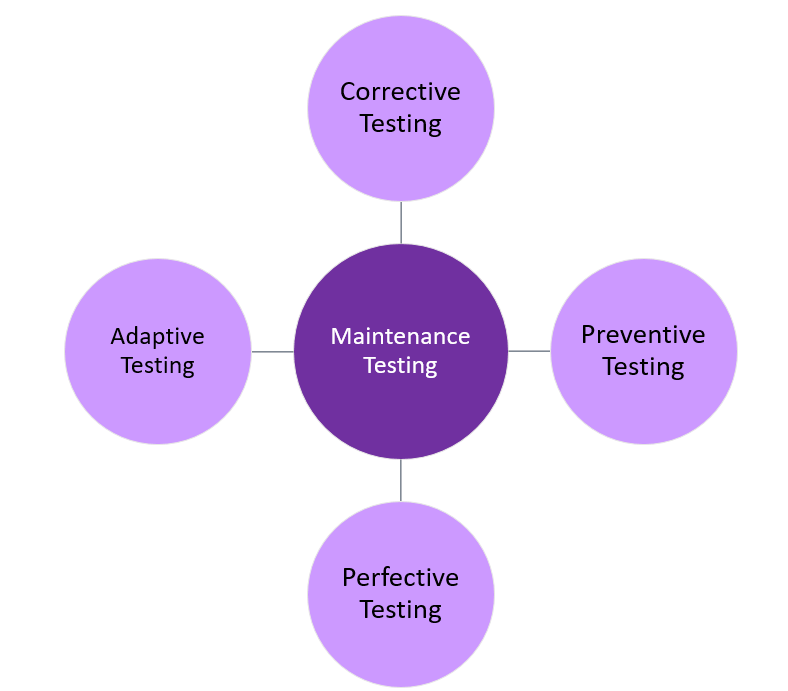

Corrective Testing
Corrective tests detect whether an already operating program has any errors. If an error is detected, it will be extracted from the code and corrected.
Advantages of Corrective testing
- The amount of planning and time needed for corrective testing is less as only the components with defects will be considered. Components that are working fine do not have to undergo corrective testing.
- Due to the above reasons, the cost required for corrective software testing is also reduced.
- The process of executing corrective tests is simple and does not require any in-depth knowledge to recognize an issue.
Disadvantages of Corrective testing
- We cannot easily predict an upcoming error in the system. So the testers should continue observing to know when an error occurs.
- Sometimes an error in one component will affect the functionality of other components. In such cases, we need to investigate all the features to identify the root cause of the problem.
Adaptive Testing
Adaptive software testing happens when an alteration is done in the system while it is live in production. Execution of these tests is necessary to guarantee the lifespan of an application functioning without any error.
Advantages of Adaptive testing
- With adaptive testing, we can figure out the suitable software solution when a hardware component of the system is modified.
- Similarly, we can grasp the suitable hardware solution when a software component of the system is modified.
Disadvantages of Adaptive testing
- Adaptive costing requires a high cost as suitable hardware or software solutions according to the modification made in the system is increased.
Perfective Testing
Perfective testing verifies the maintainability and performance of software once it is live on production.
Advantages of Perfective testing
- We can guarantee the software system is functioning effectively and efficiently while satisfying the users with perfective software testing.
- This also detects the areas of the system that need improvements and enhancements.
Disadvantages of Perfective testing
- The cost and time required for the perfective testing process are comparatively high. Test execution happens continuously and regularly to detect which parts of the system require improvements.
Preventive Testing
Preventive software testing is carried out on a working system to detect future errors and prevent them from happening early.
Advantages of Preventive testing
- With preventive testing, we can stop the upcoming system failures. Due to that reason, the time and money required to fix defects are saved.
- Preventive testing also enhances the system’s safety while running for a more extended period without any breakdown.
Disadvantages of Preventive testing
- The preventive software testing process is more complicated than other maintenance testing types.
- Preventive tests require more funding to execute.
Conclusion to the Advantages and Disadvantages of Software Testing
With the assistance of quality assurance, we can verify the proper functioning of a software application. But knowing the primary purpose of testing and many testing techniques is not sufficient to become a good testing team. Knowing the advantages and disadvantages of each test type and its usage will help you overcome that gap. Now that you know the advantages and disadvantages of the software testing types; functional testing, non-functional testing, regression testing, and maintenance testing, you can boost your product’s quality.
